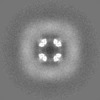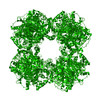[English] 日本語
 Yorodumi
Yorodumi- EMDB-26649: Endogenous dihydrolipoamide succinyltransferase (E2) core of 2-ox... -
+ Open data
Open data
- Basic information
Basic information
| Entry |  | ||||||||||||
|---|---|---|---|---|---|---|---|---|---|---|---|---|---|
| Title | Endogenous dihydrolipoamide succinyltransferase (E2) core of 2-oxoglutarate dehydrogenase complex from bovine kidney | ||||||||||||
 Map data Map data | |||||||||||||
 Sample Sample |
| ||||||||||||
 Keywords Keywords | e2 / 2-oxoglutarate / dehydrogenase / complex / TRANSFERASE | ||||||||||||
| Function / homology |  Function and homology information Function and homology informationL-lysine catabolic process to acetyl-CoA via L-saccharopine / succinyl-CoA metabolic process / dihydrolipoyllysine-residue succinyltransferase / dihydrolipoyllysine-residue succinyltransferase activity / oxoglutarate dehydrogenase complex / 2-oxoglutarate metabolic process / acyltransferase activity / tricarboxylic acid cycle / mitochondrial matrix / mitochondrion / nucleus Similarity search - Function | ||||||||||||
| Biological species |  | ||||||||||||
| Method | single particle reconstruction / cryo EM / Resolution: 3.5 Å | ||||||||||||
 Authors Authors | Liu S / Xia X / Zhen J / Li ZH / Zhou ZH | ||||||||||||
| Funding support |  United States, 3 items United States, 3 items
| ||||||||||||
 Citation Citation |  Journal: Cell Discov / Year: 2022 Journal: Cell Discov / Year: 2022Title: Structures and comparison of endogenous 2-oxoglutarate and pyruvate dehydrogenase complexes from bovine kidney. Authors: Shiheng Liu / Xian Xia / James Zhen / Zihang Li / Z Hong Zhou /  Abstract: The α-keto acid dehydrogenase complex family catalyzes the essential oxidative decarboxylation of α-keto acids to yield acyl-CoA and NADH. Despite performing the same overarching reaction, members ...The α-keto acid dehydrogenase complex family catalyzes the essential oxidative decarboxylation of α-keto acids to yield acyl-CoA and NADH. Despite performing the same overarching reaction, members of the family have different component structures and structural organization between each other and across phylogenetic species. While native structures of α-keto acid dehydrogenase complexes from bacteria and fungi became available recently, the atomic structure and organization of their mammalian counterparts in native states remain unknown. Here, we report the cryo-electron microscopy structures of the endogenous cubic 2-oxoglutarate dehydrogenase complex (OGDC) and icosahedral pyruvate dehydrogenase complex (PDC) cores from bovine kidney determined at resolutions of 3.5 Å and 3.8 Å, respectively. The structures of multiple proteins were reconstructed from a single lysate sample, allowing direct structural comparison without the concerns of differences arising from sample preparation and structure determination. Although native and recombinant E2 core scaffold structures are similar, the native structures are decorated with their peripheral E1 and E3 subunits. Asymmetric sub-particle reconstructions support heterogeneity in the arrangements of these peripheral subunits. In addition, despite sharing a similar monomeric fold, OGDC and PDC E2 cores have distinct interdomain and intertrimer interactions, which suggests a means of modulating self-assembly to mitigate heterologous binding between mismatched E2 species. The lipoyl moiety lies near a mobile gatekeeper within the interdomain active site of OGDC E2 and PDC E2. Analysis of the twofold related intertrimer interface identified secondary structural differences and chemical interactions between icosahedral and cubic geometries of the core. Taken together, our study provides a direct structural comparison of OGDC and PDC from the same source and offers new insights into determinants of interdomain interactions and of architecture diversity among α-keto acid dehydrogenase complexes. | ||||||||||||
| History |
|
- Structure visualization
Structure visualization
| Supplemental images |
|---|
- Downloads & links
Downloads & links
-EMDB archive
| Map data |  emd_26649.map.gz emd_26649.map.gz | 13.2 MB |  EMDB map data format EMDB map data format | |
|---|---|---|---|---|
| Header (meta data) |  emd-26649-v30.xml emd-26649-v30.xml emd-26649.xml emd-26649.xml | 17 KB 17 KB | Display Display |  EMDB header EMDB header |
| FSC (resolution estimation) |  emd_26649_fsc.xml emd_26649_fsc.xml | 13.5 KB | Display |  FSC data file FSC data file |
| Images |  emd_26649.png emd_26649.png | 172.5 KB | ||
| Masks |  emd_26649_msk_1.map emd_26649_msk_1.map | 216 MB |  Mask map Mask map | |
| Filedesc metadata |  emd-26649.cif.gz emd-26649.cif.gz | 5.8 KB | ||
| Others |  emd_26649_half_map_1.map.gz emd_26649_half_map_1.map.gz emd_26649_half_map_2.map.gz emd_26649_half_map_2.map.gz | 165.1 MB 164.9 MB | ||
| Archive directory |  http://ftp.pdbj.org/pub/emdb/structures/EMD-26649 http://ftp.pdbj.org/pub/emdb/structures/EMD-26649 ftp://ftp.pdbj.org/pub/emdb/structures/EMD-26649 ftp://ftp.pdbj.org/pub/emdb/structures/EMD-26649 | HTTPS FTP |
-Validation report
| Summary document |  emd_26649_validation.pdf.gz emd_26649_validation.pdf.gz | 635.6 KB | Display |  EMDB validaton report EMDB validaton report |
|---|---|---|---|---|
| Full document |  emd_26649_full_validation.pdf.gz emd_26649_full_validation.pdf.gz | 635.2 KB | Display | |
| Data in XML |  emd_26649_validation.xml.gz emd_26649_validation.xml.gz | 21 KB | Display | |
| Data in CIF |  emd_26649_validation.cif.gz emd_26649_validation.cif.gz | 27.9 KB | Display | |
| Arichive directory |  https://ftp.pdbj.org/pub/emdb/validation_reports/EMD-26649 https://ftp.pdbj.org/pub/emdb/validation_reports/EMD-26649 ftp://ftp.pdbj.org/pub/emdb/validation_reports/EMD-26649 ftp://ftp.pdbj.org/pub/emdb/validation_reports/EMD-26649 | HTTPS FTP |
-Related structure data
| Related structure data | 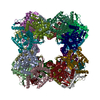 7uolMC 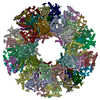 7uomC M: atomic model generated by this map C: citing same article ( |
|---|---|
| Similar structure data | Similarity search - Function & homology  F&H Search F&H Search |
- Links
Links
| EMDB pages |  EMDB (EBI/PDBe) / EMDB (EBI/PDBe) /  EMDataResource EMDataResource |
|---|---|
| Related items in Molecule of the Month |
- Map
Map
| File |  Download / File: emd_26649.map.gz / Format: CCP4 / Size: 216 MB / Type: IMAGE STORED AS FLOATING POINT NUMBER (4 BYTES) Download / File: emd_26649.map.gz / Format: CCP4 / Size: 216 MB / Type: IMAGE STORED AS FLOATING POINT NUMBER (4 BYTES) | ||||||||||||||||||||||||||||||||||||
|---|---|---|---|---|---|---|---|---|---|---|---|---|---|---|---|---|---|---|---|---|---|---|---|---|---|---|---|---|---|---|---|---|---|---|---|---|---|
| Projections & slices | Image control
Images are generated by Spider. | ||||||||||||||||||||||||||||||||||||
| Voxel size | X=Y=Z: 1.36 Å | ||||||||||||||||||||||||||||||||||||
| Density |
| ||||||||||||||||||||||||||||||||||||
| Symmetry | Space group: 1 | ||||||||||||||||||||||||||||||||||||
| Details | EMDB XML:
|
-Supplemental data
-Mask #1
| File |  emd_26649_msk_1.map emd_26649_msk_1.map | ||||||||||||
|---|---|---|---|---|---|---|---|---|---|---|---|---|---|
| Projections & Slices |
| ||||||||||||
| Density Histograms |
-Half map: #2
| File | emd_26649_half_map_1.map | ||||||||||||
|---|---|---|---|---|---|---|---|---|---|---|---|---|---|
| Projections & Slices |
| ||||||||||||
| Density Histograms |
-Half map: #1
| File | emd_26649_half_map_2.map | ||||||||||||
|---|---|---|---|---|---|---|---|---|---|---|---|---|---|
| Projections & Slices |
| ||||||||||||
| Density Histograms |
- Sample components
Sample components
-Entire : Endogenous dihydrolipoamide succinyltransferase (E2) core of 2-ox...
| Entire | Name: Endogenous dihydrolipoamide succinyltransferase (E2) core of 2-oxoglutarate dehydrogenase complex from bovine kidney |
|---|---|
| Components |
|
-Supramolecule #1: Endogenous dihydrolipoamide succinyltransferase (E2) core of 2-ox...
| Supramolecule | Name: Endogenous dihydrolipoamide succinyltransferase (E2) core of 2-oxoglutarate dehydrogenase complex from bovine kidney type: complex / ID: 1 / Parent: 0 / Macromolecule list: all |
|---|---|
| Source (natural) | Organism:  |
| Molecular weight | Theoretical: 49 KDa |
-Macromolecule #1: Dihydrolipoyllysine-residue succinyltransferase component of 2-ox...
| Macromolecule | Name: Dihydrolipoyllysine-residue succinyltransferase component of 2-oxoglutarate dehydrogenase complex, mitochondrial type: protein_or_peptide / ID: 1 / Number of copies: 24 / Enantiomer: LEVO / EC number: dihydrolipoyllysine-residue succinyltransferase |
|---|---|
| Source (natural) | Organism:  |
| Molecular weight | Theoretical: 49.034414 KDa |
| Sequence | String: MLSRSRCASR AFSRSLSAFQ KGNCPLVRRS LPGISLCQGP GYPDSRKTVI NSSNIFSVRF FRTTAVCKDD VITVKTPAFA ESVTEGDVR WEKAVGDTVA EDEVVCEIET DKTSVQVPSP ANGVIEALLV PDGGKVEGGT PLFTLRKTGA APAKAKPAAA P AAAAPKAE ...String: MLSRSRCASR AFSRSLSAFQ KGNCPLVRRS LPGISLCQGP GYPDSRKTVI NSSNIFSVRF FRTTAVCKDD VITVKTPAFA ESVTEGDVR WEKAVGDTVA EDEVVCEIET DKTSVQVPSP ANGVIEALLV PDGGKVEGGT PLFTLRKTGA APAKAKPAAA P AAAAPKAE PTVSAVPPPP AAPIPTQMPP VPSPSQPLTS KPVSAVKPTA APPRAEAGAG VGLRSEHREK MNRMRQRIAQ RL KEAQNTC AMLTTFNEID MSNIQEMRAR HKDAFLKKHN LKLGFMSAFV KASAFALQEQ PVVNAVIDDA TKEVVYRDYI DIS VAVATP RGLVVPVIRN VETMNYADIE RTISELGEKA RKNELAIEDM DGGTFTISNG GVFGSLFGTP IINPPQSAIL GMHA IVDRP VVIGGKVEVR PMMYVALTYD HRLIDGREAV TFLRKIKAAV EDPRVLLLDL UniProtKB: Dihydrolipoyllysine-residue succinyltransferase component of 2-oxoglutarate dehydrogenase complex, mitochondrial |
-Experimental details
-Structure determination
| Method | cryo EM |
|---|---|
 Processing Processing | single particle reconstruction |
| Aggregation state | particle |
- Sample preparation
Sample preparation
| Buffer | pH: 7 |
|---|---|
| Grid | Model: PELCO Ultrathin Carbon with Lacey Carbon / Material: COPPER / Support film - Material: CARBON / Support film - topology: LACEY / Pretreatment - Type: GLOW DISCHARGE |
| Vitrification | Cryogen name: ETHANE / Chamber humidity: 100 % / Chamber temperature: 281 K / Instrument: FEI VITROBOT MARK IV |
- Electron microscopy
Electron microscopy
| Microscope | FEI TITAN KRIOS |
|---|---|
| Image recording | Film or detector model: GATAN K2 SUMMIT (4k x 4k) / Detector mode: SUPER-RESOLUTION / Average exposure time: 8.0 sec. / Average electron dose: 45.0 e/Å2 |
| Electron beam | Acceleration voltage: 300 kV / Electron source:  FIELD EMISSION GUN FIELD EMISSION GUN |
| Electron optics | Illumination mode: FLOOD BEAM / Imaging mode: BRIGHT FIELD / Cs: 2.7 mm / Nominal defocus max: 2.6 µm / Nominal defocus min: 1.8 µm / Nominal magnification: 105000 |
| Sample stage | Specimen holder model: FEI TITAN KRIOS AUTOGRID HOLDER / Cooling holder cryogen: NITROGEN |
| Experimental equipment |  Model: Titan Krios / Image courtesy: FEI Company |
+ Image processing
Image processing
-Atomic model buiding 1
| Initial model | PDB ID: Chain - Source name: PDB / Chain - Initial model type: experimental model |
|---|---|
| Software | Name: UCSF ChimeraX |
| Refinement | Space: REAL / Protocol: BACKBONE TRACE |
| Output model |  PDB-7uol: |
 Movie
Movie Controller
Controller




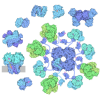

 Z (Sec.)
Z (Sec.) Y (Row.)
Y (Row.) X (Col.)
X (Col.)

































